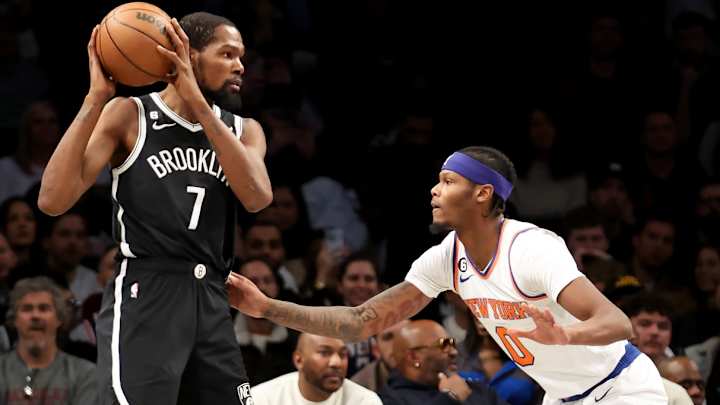Mavs Trade Pursuit of Knicks' Cam Reddish Faces Multiple Obstacles

In this story:
The Dallas Mavericks enter Thursday's matchup against the New Orleans Pelicans holding a 27-25 record. They still rank fifth in the Western Conference standings, but as many teams have experienced, a few losses can sink any team's ranking in a hurry. If there is a reasonable opportunity to improve ahead of the Feb. 9 trade deadline, taking advantage of it would help.
There are multiple types of trades that can get done by a team midseason. Without using a significant amount of future draft capital, taking a flier on a player that isn't getting the job done in their current situation is an option. Cam Reddish, who still hasn't even appeared in a game since Dec. 3, is among the names the Mavs have been linked to in recent trade rumors.
The production that Reddish has shown since being selected 10th overall in the 2019 NBA Draft isn't necessarily going to prompt the league's power brokers to be aggressive in acquiring him. While he has potential, he is a largely unproven player set to reach restricted free agency in the summer.
The type of trade a team would make for Reddish would be similar in mechanics to the deal that sent Rui Hachimura from the Washington Wizards to the Los Angeles Lakers. The only contract sent out was Kendrick Nunn's $5.3 million expiring salary with three second-round picks attached.
When asking members of rival front offices for their expertise, DallasBasketball.com was pointed toward multiple potential obstacles that the Mavs face in the pursuit of a Reddish trade. It begins with the lack of a readily available expiring contract of a player that could contribute and accomplishes the need to achieve salary matching.
Reddish is earning $5.9 million in the final year of his rookie contract. The Mavs have eight players earning over $10 million in 2022-23. Maxi Kleber, who is earning $9 million, is ineligible to be dealt. The obvious player to attempt to include in a trade package is JaVale McGee given his near $5.5 million salary and his lack of a rotational role.
Had JaVale McGee received a one-year deal as opposed to being signed through 2024-25, it's much more likely that a potential trade suitor would be able to stomach the thought of taking him back in a trade. Right now, he has a contract that is undesirable, to say the least.
Another problem the Mavs face is they have quietly exhausted much of their second-round draft capital. They sent out two future second-round picks to gain positioning to acquire the 37th overall pick in the 2022 NBA Draft, affording them the opportunity to select Jaden Hardy. They already are sending out their second-round pick in 2023, 2024, 2026, and 2028.
When looking at the 30,000-foot view, there isn't much reason to part with a young player that has realized their potential as a complementary talent like Josh Green for a player like Reddish, who has yet to do so. Adding further complication to the matter, again, Reddish will reach restricted free agency in the offseason.
There is a theoretical option of trying to make a trade package into a bigger deal by involving larger salaries, like Reggie Bullock. While the Mavs see a productive 3-and-D wing that's integral to their success, most of the NBA sees a soon-to-be 32-year-old wing who has experienced declining production annually since the 2020-21 season.
Bullock has only about $5.5 million guaranteed of his $10.5 final-year salary for next season. It becomes fully guaranteed in late June. A team wouldn't be acquiring him midseason to later waive him, leaving them with $5.5 million dead salary cap spending. It's not the most appealing contract for someone averaging just 6.5 points while shooting 39.0 percent from the floor and 36.4 percent from 3-point range.
The Mavs may need to take into consideration that moving Bullock now would leave them with one less movable expiring contract in the upcoming offseason, or next year's trade deadline. In the offseason, they will only have Spencer Dinwiddie, Bullock, and Green entering the final year of their current contracts.
There is a lesson to be learned in this situation. It begins with not investing too heavily into career backups like McGee using the taxpayer MLE, especially when that player will be 35 during the first year of the contract. It's all the more concerning when reflecting on the promise of a starting role to begin the season.
With how much teams spend and operate above the salary cap, the new mechanisms to add talent is to have draft capital and fair value contracts that teams are willing to take back in a trade. The other way of doing so is to effectively use exceptions like the mid-level, tax-payer, and bi-annual on player that actually contribute. If those get messed up, it gets complicated.
Want the latest in breaking news and insider information on the Dallas Mavericks? Click Here.
Follow DallasBasketball.com on Twitter and Facebook.
Follow Grant Afseth on Twitter.

Grant Afseth is a Dallas Mavericks reporter for MavericksGameday.com and an NBA reporter for NBA Analysis Network. He previously covered the Indiana Pacers and NBA for CNHI's Kokomo Tribune and various NBA teams for USA TODAY Sports Media Group. Follow him on Twitter (@grantafseth), Facebook (@grantgafseth), and YouTube (@grantafseth). You can reach Grant at grantafseth35@gmail.com.
Follow GrantAfseth